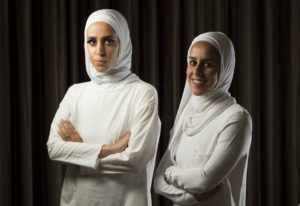MISHREF, Kuwait — On a perfectly breathable Friday near sunset in the spring, you might have spotted what residents say you never would have spotted 10 years ago: women, here and there, on the pathways that twist near a sports park, walking briskly or jogging, in their abayas.
Look more carefully, and you would have noticed another novel sight of the 2010s: six cyclists on their bikes, zipping back and forth, coed — four men in helmets, two women in helmets and hijabs.

These two sisters have happened upon a passion for triathlon in their 20s, and the sport has driven them around the world and even to the wilds of eBay. That’s where Najla Al Jeraiwi, determined that being covered would not impede being competitive, bought 15 body suits some time ago, fearing their obsolescence because swimming’s governing body had banned them from world competition. She gave three to her sister Nada. She gave four to friends. “I have the rest, but with time it’s getting worn down,” she said. “So now we’re struggling.”
Count the Al Jeraiwi sisters, all inconspicuous 5 feet 1 (Najla) and 5 feet 3 (Nada) of them, among a fresh wavelet of human athletes: women who find sport such an essential part of themselves that they compete in traditional hijab headscarves, loose-fitting abaya robes or other covering.
Especially for triathlon, that combination of swimming, cycling and running, this means exhaustive searches for ever more agreeable fabrics. It means there’s a novel fashion item of the 21st century, the sport hijab, and a trickle of companies making it.
Hijabs and abayas, both a tradition and a personal choice in most Middle Eastern cultures, have begun to dovetail more with sports. They have appeared with flair, such as when Shinoona Al Habsi, then a 19-year-old runner for Oman, entered the Olympic Stadium at the London Games four years ago to run the 100 meters in a memorable hijab of a fine red, “red because of Oman,” she said, referring to a dominant color in the country’s flag.
They have caused policy advancements, such as when FIFA, the world governing body of soccer, opted to allow hijabs in early 2014. “Look, it’s a popular sport,” Prince Ali bin Al Hussein of Jordan, a FIFA member archly supportive of women’s sports, said in an interview. “We had, for example in West Asia, we had a tournament. I’m president of the West Asian Football Federation. And when we first introduced women’s football, the Iranians resisted by saying they would not allow their girls to play if men are present in stadiums. But if you put it to them properly, which we did, they have to accept the status quo. And things are easy to move ahead.
“We had the same issue with headscarves. The way we did it in FIFA was to say that, ‘Look, you have to have mutual respect.’ In fact, our women were the first girls who went and played in Iran without headscarves after the decisions were made. So there’s a lot of things that can be done as long as we take the politics out of it.”
Yasmeen Khair called it “one of the best decisions that was made.” Khair, a defender on Jordan’s women’s national soccer team and a designated ambassador for Jordan’s upcoming Under-17 Women’s World Cup, said, “In Arab countries, hijab, it’s a main thing, you know. In our team, we had a lot of girls wearing hijab. . . . Three, four of them, they were with the national team, and they were some of the main players, you know? So if this decision wasn’t made, then you’re going to lose a lot of the girls playing football. Even the young ones.”
Read more: Muslim female athletes find sport so essential they compete while covered
Source: Washington post


